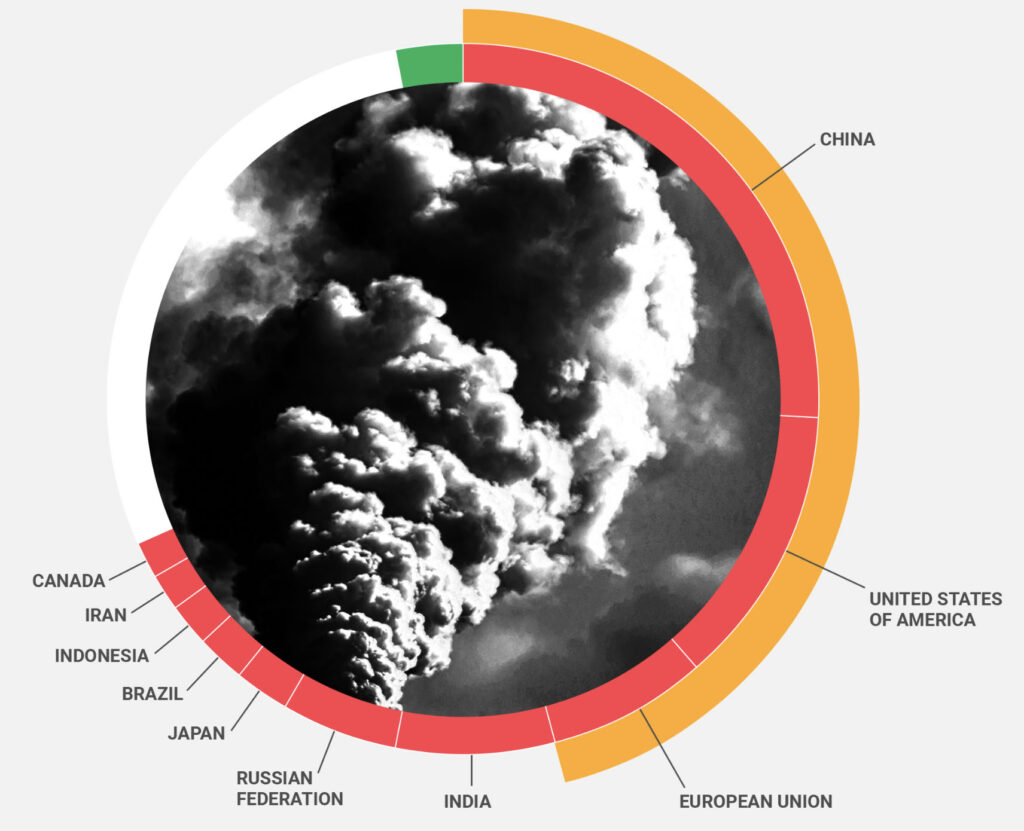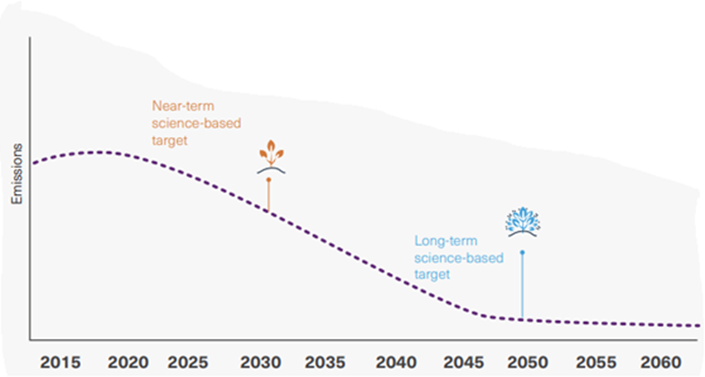It is clear that the planet is warming due to the anthropogenic activities; but it is also clear now that the impacts to the natural biodiversity and our own survival associated to a warmer planet goes beyond a mere adaption to a hotter weather as it is threatening our existence and continuity in this planet Earth. Humanity has realised that we need to take immediate action and it is demanding industries to take responsibility for their business’ activities. It is our duty to take that call. This post will answer how to achieve Net-Zero in your business. Are you ready to take action and set your business for Net-Zero success?
The science shows clearly that in order to avert the worst impacts of climate change and preserve a livable planet, global temperature increase needs to be limited to 1.5°C above pre-industrial levels. Currently, the Earth is already about 1.1°C warmer than it was in the late 1800s, and emissions continue to rise. To keep global warming to no more than 1.5°C – as called for in the Paris Agreement – emissions need to be reduced by 45% by 2030 and reach Net Zero by 2050.
It calls for nothing less than a complete transformation of how we produce, consume, and move about, and it takes a commitment from every individual living in this planet to make it possible.
“Governments have the lion’s share of responsibility to achieve net-zero emissions by mid-century. Especially the G20. But we also urgently need every business, investor, city, state and region to walk the talk on their net-zero promises” the Secretary-General António Guterres said. “We need to ensure net-zero commitments are ambitious and credible, and that they align with the highest standards of environmental integrity and transparency” added.
There is a clear growing urgency for commitments at all levels to be transparent, credible, backed by robust action plans, and converted into real emissions cuts as rapidly as possible. But the real questions are what is Net Zero and what does it mean for my business?
WHAT DOES NET-ZERO MEAN
Net zero means cutting greenhouse gas emissions to as close to zero as possible, with any remaining emissions re-absorbed from the atmosphere to be captured by oceans, forests or any other sequestration process, in order to meet 1.5°C global warming target of the Paris Agreement.
However, this initially straight forward Net Zero target might lead to quite different roadmap scenarios and the employment of different mechanisms at different levels of the participating actors. Moreover, there are some grey areas at all levels that will require honesty and integrity from all contributors.
A Country-level Net Zero target will require deep restructuration of the environmental legislation and annual budget, including grants, penalties and rewards schemes to curve emissions reductions to as low as feasibly possible, and the employment natural or technologically induced Greenhouse Gas removals for the remaining counts to achieve carbon neutrality. However, Country-level emissions accounting will only be reported from the emissions that directly arise from activities within the Country’s geographical boundary. This can be a double edge sword, as in one hand prevents double counting of emissions, but in the other hand could lead to Countries outsourcing materials and products previously obtained in Country to reduce their Carbon count, leading to even more Carbon emissions just from transportation.
At a Community-level, a Net Zero city or region will greatly depend on how to count for the urban carbon emissions, since a city or a region is not isolated from other communities, there are some transboundary issues, such as transportation, electricity and water resources, or even food supplies that will require a community-demand approach of the supply chain tracking.
For Corporations, the Science Based Targets initiative (SBTi) has defined Net Zero as the societal climate goal that:
- achieves a scale of value-chain emission reductions consistent with the depth of abatement achieved in pathways that limit warming to 1.5°C with no or limited overshoot and;
- neutralises the impact of any source of residual emissions that remains unfeasible to be eliminated by permanently removing an equivalent amount of atmospheric carbon dioxide.
WHAT DOES NET-ZERO MEAN FOR MY BUSINESS
Although up to 46% of the global emissions are caused by just 3 big polluters – China, the United States, and the European Union – a coalition of countries, cities, businesses and other institutions are pledging to get to net-zero emissions. More than 70 countries have set a net-zero target, covering about 76% of global emissions. So far, 5,235 companies, 1,049 cities, 67 regions, 1,039 educational institutions, and 441 financial institutions have joined the Race to Zero, pledging to take rigorous, immediate action to halve global emissions by 2030 and achieve Net Zero by 2050, the latest.

There are certain science-based mitigation pathways which the IPCC SR15 highlighted to limit warming to 1.5°C with no or limited overshoot (overshoot <0.1°C) due to the shocking new findings on previously underestimated impacts to human health, society, and nature associated with 1.5°C of warming and the risk of exceeding 1.5°C and going towards 2°C as previously tolerated. Therefore the SR15 describes scenarios that limit warming to 1.5°C with no or limited overshoot reaching net-zero CO2 emissions around 2050, accompanied by rapid reductions in non-CO2 GHG emissions, which entails profound transitions in the global energy, industry, urban, and land systems that involve:
- Full or near-full decarbonization for energy and industrial CO2 emissions achieving a zero-emissions energy supply system by mid-century.
- Eliminating CO2 emissions associated with agriculture, forestry, and land-use
- Deep reductions in non-CO2 emissions from all sectors.
- Removing CO2 from the atmosphere to neutralize residual emissions and, potentially, sustain net negative emissions that reduce cumulative CO2 in the atmosphere over time.
They need to occur simultaneously and all of them are needed for society to reach net-zero emissions and limit warming to 1.5°C due to the synergies and trade-offs between different climate change mitigation scenarios.
Whether you conduct business on a local, regional, national or international level, Net Zero will impact the way you do business from now on. New customers and clients will likely select products and services that have got lower carbon footprint than others and investors will favour investments based on pre-established ‘transparent, credible, backed by robust action plans, and converted into real emissions cuts’ ESG criteria.
Noting that there are no 2 identical businesses, your journey to Net-Zero in your company will require an strategy, normally embedded in your ESG Strategy, tailored to your business context. However, there are some high level considerations to design a SMART strategy:
- It must be aligned to the wider business strategy and stakeholder priorities.
- It should take into account projected business growth to avoid falling short of the target.
- It should be fed by an understanding of the risks and opportunities posed to your organisation by climate change and social imbalance.
- It should be championed by Senior Management and fully supported by the executive management level.
- Any objective/target should allow for transparent and credible data collection, monitoring and reporting systems.
- understand the financial investment required to activate change in your organization.
- Full alignment with Net Zero Standard.
- It must also have a credible strategy for offsetting.
- Follow internationally recognised standards and pursue certifications from reputable and experienced suppliers.
The goals you choose should do more than benefit your organisation from a carbon perspective, but have a positive social and environmental impact on the communities in which you operate.
HOW CAN MY BUSINESS ACHIEVE NET-ZERO
There are many different transition pathways toward achieving a state of Net-Zero emissions at the global level, each with different implications for our climate, for nature, and for society, but it should be consistent with societal climate and sustainability goals.
Companies must deeply reduce emissions to Zero or to a residual level and counterbalance the impact of any emissions that remain using alternative offset mechanisms.
Your business strategy to Net-Zero should consider the following key elements of an efficient and rounded Net-Zero strategy (for SME only):
- To set Near-Term Science-Based Targets (SBT): 5–10 year emission reduction targets in line with 1.5°C pathways, which are absolute scope 1 and 2 Green House Gases (GHG) emissions reduction targets that should be achieved by 2030, from a predefined base year.
- To set Long-Term SBTs: Target to reduce emissions to a residual level in line with 1.5°C scenarios, which are absolute scope 1, 2 and 3 GHG emissions reduction targets that should be achieved by 2050, from a predefined base year.
- It is recommended to go ‘Beyond Value Chain’ mitigation: There is an urgent need to scale up near-term climate finance. Therefore making investments outside the science-based targets that help mitigate climate change elsewhere is encouraged. However, these investments should be in addition to deep emission cuts, not instead of them
- Neutralization of residual emissions: GHGs released into the atmosphere when the company has achieved their long-term SBT must be counterbalanced through the permanent removal and storage of carbon from the atmosphere.
How to achieve Net-Zero in your business will involve the establishment, implementation and follow up on success of your business Net-Zero Strategy in 5 main steps:
- Form a Net-Zero Team championed by a Senior Management level
- Select a Base Year and complete an emission inventory following the GHG Protocol
- Set Near- and Long-Term science-based targets to reduce value chain emissions using Net-Zero Standard Criteria and the Target Validation Protocol
- Implement the strategy to achieve science-based targets.
- Disclose target progress annually using the GHG Protocol Standard, the Scope 2 Guideline and the GHG Protocol (Scope 3) Standard.
Form a Net-Zero Team championed by a Senior Management level
The best way to set your company for Net-Zero success, is to assign this project to a competent team that should be led by a Senior Manager with authority to make strategic and financial decisions.
This should not mean that the whole burden of achieving the targets is the team’s accountability but surely they should be responsible for defining a SMART Strategy, measuring and monitoring its correct implementation, and reporting through the appropriate channels.
However, the only way to success is obtaining every employee, supplier and vendor’s buy-in to the plan. And for that the CEO shall be fully committed to the implementation of the strategy in its full extend, without exceptions, exclusions or concessions.
Once the team is formed, needs for training of team, if required, should be identified to make sure that the team is competent to define, establish, implement and maintain the Net-Zero Strategy Project throughout its lifespan. Additionally, other training needs will also be identified within the rest of the company departments to confirm that the different actors understand what is required from them and are capable of accomplishing the required actions that are needed from them to achieve the intended targets.
Once the team is formed, it is the team’s responsibility to design a credible strategy for which the input from all the different departments shall be collected and analysed.
Select a Base Year and complete an emission inventory
- Select Base Year
Companies need to establish a base year to track emissions performance consistently and meaningfully over the target period. The following considerations are important for selecting a base year:
- Scope 1, 2, (and 3 emissions) data should be accurate and verifiable.
- Base year emissions should be representative of a company’s typical GHG profile. Alternatively, companies may use a multi-year average base year approach.
- The base year should be chosen such that targets have sufficient forward-looking ambition.
- The base year must be no earlier than 2015.
- The base year will be fixed for both, Near-Term and Long-Term science-based targets.
- Calculate the emissions inventory:
Companies are required to have a thorough emissions inventory that covers at least 95% of company-wide scope 1 and 2 GHG emissions, and a complete scope 3 screening when applicable.
You should note the following considerations:
- the target boundary will need to be aligned with the GHG Inventory boundary: a single GHG Protocol defined method should be used for the GHG inventory boundaries and that same method will be used to define science-based target boundaries. For more information on organizational boundary-setting, please see the SBTi Corporate Manual and the GHG Protocol Corporate Standard.
- Determine how to treat subsidiaries, if applicable.
- Exclude the use of carbon credits: Carbon credits do not count as reductions toward meeting your science-based targets. Companies should only account for reductions that occur within their operations and value chain.
- Exclude avoided emissions: A company’s product avoids emissions if it has lower life cycle GHG
- emissions relative to some other company’s product that provides an equivalent function. Avoided emissions occur outside of the product’s life cycle and therefore do not count as a reduction of a company’s scope 1, 2 and 3 inventory. For more information on avoided emission, please see the SBTi Corporate Manual and the World Resources Institute paper on avoided emissions.
- Include all mandatory scope 3 emissions: Companies must develop a complete scope 3 inventory, which is critical for identifying emissions hotspots, reduction opportunities, and areas of risk up and down the value chain.
- Review any sector-specific guidance
- Calculate emissions that are reported separately from the GHG inventory:
- Companies that use bioenergy must report direct CO2 emissions from biomass combustion, processing, and distribution, as well as the land-use emissions and removals associated with bioenergy feedstock. These emissions are reported separately from the company’s GHG inventory, in line with Greenhouse Gas Protocol guidance.
- Companies that sell or distribute fossil fuels are required to report the use-phase emissions associated with those fossil fuels in scope 3 and cover these emissions with a target.
- Companies are also encouraged to report GHG emissions from land-use change although these are not currently required.
Set Near- and Long-Term science-based targets
- A comprehensive target boundary is necessary for companies to make credible net-zero claims at the end of their decarbonization journey. However, it can be quite challenging to define scope 3 emissions. The SBTi Net-Zero Standard follows an progressively expanding boundary approach and a gradual increase in ambition.
- Near-term science-based targets must cover at least 95% of your company-wide scope 1 and 2 emissions, but if your company’s scope 3 emissions reach or exceed 40% of total your company’s emissions (scope 1, 2, and 3 emissions), then, at least, 67% of scope 3 emissions must also be covered with Near-term science-based targets.
- Long-term SBTs must cover at least 95% of company-wide scope 1 and 2 emissions and 90% of scope 3 emissions.

- Near-term target year should be accomplished prior 2030, while long-term targets should be achieved before 2050 or as early as in 2040 for certain sectors (i.e.: power sector)
- For most of the businesses, Near-Term targets that reduce emissions at a linear annual rate of 4.2% will be required unless your company conducts businesses within the power generation sector and forestry, land-use, and agriculture (FLAG) sectors, for which other sector-specific targets have been set. Subsequently, Long-Term science-based targets will be equivalent to at least a 90% absolute reduction across scopes regardless of the sector your company trades in. However, there are other eligible methods to calculate targets depending on the sector where your company does business in and the emission scope for which the target is calculated. The SBTi Net-Zero Standard Criteria and the SBTi Net-Zero Standard can be consulted for further clarity and guidance.
Going Beyond Value Chain
In parallel to your business Net-Zero Strategy, going ‘Beyond Value Chain’ will support the urgent need of scaling up finance in the near-term to support climate mitigation. Investing in near-term and long-term global climate mitigation strategies will not only contribute to alleviate the additional impact of the transition period, but also holding the increase to 1.5°C above pre-industrial levels, and ideally contributing to turn the clock back in the global temperature rise, if feasible possible.
- In the near-term: prioritize securing and enhancing carbon sinks (terrestrial, coastal and marine, etc.) to avoid the emissions that arise from their degradation. There is also a critical need for companies to invest in nascent GHG removal technologies (e.g. direct air capture (DAC) and storage).
- In the long-term: when the net-zero target date is reached, companies must neutralize any residual emissions by permanently removing carbon from the atmosphere. Companies must continue to neutralize any remaining emissions.
However, remember that these investments should be in addition to deep emission cuts, not instead of them.
Implementation, Reporting and Recalculation
Once the strategy design is completed, it is time for the different units of your company to take real action to implement the targets. The team shall ensure continuous measuring and checking of the implementation stage to be able to correct any deviation from plan in a short period.
Otherwise, your company could fall into false security to just find out at the end of the near-term that the intended targets were not achieved and recalculation for even higher-expectations need to be redesign to achieve Net-Zero in the long-term.
One simple way of making sure that worse the described scenario does not take place is to select a voluntary reporting platform to keep your targets on track and showcase your achievements. There are various reporting platforms and you should select the one who best suits your business.
Did you find this post useful? Please leave us your comments. We would like to hear from you and improve our content to better serve you!

